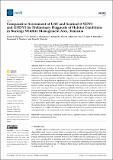| dc.description.abstract | Habitat condition is a vital ecological attribute in wildlife conservation and management
in protected areas, including the Burunge wildlife management areas in Tanzania. Traditional
techniques, including satellite remote sensing and ground-based techniques used to assess habitat
condition, have limitations in terms of costs and low resolution of satellite platforms. The Normalized
Difference Vegetation Index (NDVI) and Green NDVI (GNDVI) have potential for assessing habitat
condition, e.g., forage quantity and quality, vegetation cover and degradation, soil erosion and
salinization, fire, and pollution of vegetation cover. We, therefore, examined how the recently emerged
Unmanned Aerial Vehicle (UAV) platform and the traditional Sentinel-2 differs in indications of
habitat condition using NDVI and GNDVI. We assigned 13 survey plots to random locations in the
major land cover types: three survey plots in grasslands, shrublands, and woodlands, and two in
riverine and mosaics cover types. We used a UAV-mounted, multi-spectral sensor and obtained
Sentinel-2 imagery between February and March 2020. We categorized NDVI and GNDVI values into
habitat condition classes (very good, good, poor, and very poor). We analyzed data using descriptive
statistics and linear regression model in R-software. The results revealed higher sensitivity and
ability of UAV to provide the necessary preliminary diagnostic indications of habitat condition. The
UAV-based NDVI and GNDVI maps showed more details of all classes of habitat conditions than
the Sentinel-2 maps. The linear regressions results showed strong positive correlations between the
two platforms (p < 0.001). The differences were attributed primarily to spatial resolution and minor
atmospheric effects. We recommend further studies to test other vegetation indices. | en_US |

